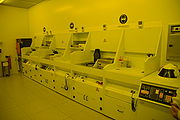- Spin-coating
-
Die Rotationsbeschichtung (engl. spin coating auch spin-on) ist ein Verfahren zum Auftragen dünner und gleichmäßiger Schichten bzw. Filme auf einem Substrat. Zum Aufschleudern eignen sich alle in Lösung vorliegenden Materialien, wie der in der Mikroelektronik verwendete Fotolack.
Inhaltsverzeichnis
Prozessablauf
Das Substrat, oft ein Wafer, wird auf einem Drehteller, dem Chuck, mittels Vakuumansaugung an der Unterseite fixiert. Mit einer Dosiereinrichtung über dem Zentrum des Wafers wird die gewünschte Menge der Lösung aufgebracht. Beschleunigung, Enddrehzahl und Zeit werden am Spin-coater eingestellt, und die Lösung wird gleichmäßig über die Waferoberfläche verteilt. Eventuell überschüssiges Material wird vom Wafer abgeschleudert. Typischerweise werden Polymerlösungen verwendet, wobei auch die molare Masse und deren Verteilung einen direkten Einfluss auf die Filmdicke haben (Details, Modelle und nützliche Gleichungen siehe [1]).
Um eine feste Schicht zu erhalten, ist es notwendig, das Lösungsmittel zu entfernen. Ein Teil des Lösungsmittel verflüchtigt sich schon beim Aufschleudern. Dies kann durch einen beheizten Chuck oder durch anschließendes Ausheizen (Tempern, Soft Bake) erhöht werden.
Verwendung
Angewendet wird das Verfahren bei der Belackung von Wafern in der Mikroelektronik und der Mikrosystemtechnik. Die resultierende Schichtdicke auf dem Wafer ist abhängig von der Viskosität des Fotolacks, der Drehgeschwindigkeit, Beschleunigung und Prozessdauer der Rotationsbeschichtung.
In der Mikroelektronik sind Schichtdicken von einem Mikrometer und darunter üblich, da hier der Fotolack (engl.: resist) nur als Deckschicht dient. Die Strukturen werden später direkt in den Wafer geätzt. In der Mikrosystemtechnik werden auch höhere Strukturen benötigt. In diesem Bereich werden Schichtdicken bis in den Millimeterbereich in einem oder mehreren Prozessschritten aufgebaut, da die herzustellenden Strukturen häufig mithilfe des Fotolacks, z. B. durch galvanische Verfahren, erstellt werden.
Einzelnachweise
- ↑ Dirk W. Schubert, Thomas Dunkel: Spin coating from a molecular point of view: its concentration regimes, influence of molar mass and distribution. In: Materials Research Innovations 7, 2003, S. 314–321 (doi:10.1007/s10019-003-0270-2)
Literatur
- K. Norrman, A. Ghanbari-Siahkali, N. B. Larsen: Studies of spin-coated polymer films. In: Annual Reports Section C (Physical Chemistry). 101, 2005, S. 174–201 (doi:10.1039/b408857n) (frei zugänglich).
Weblinks
- Spin coating process. Columbia University Center for Integrated Science and Engineering. Abgerufen am 5. Mai 2009. (PDF, 220 KB, englisch)
Wikimedia Foundation.

